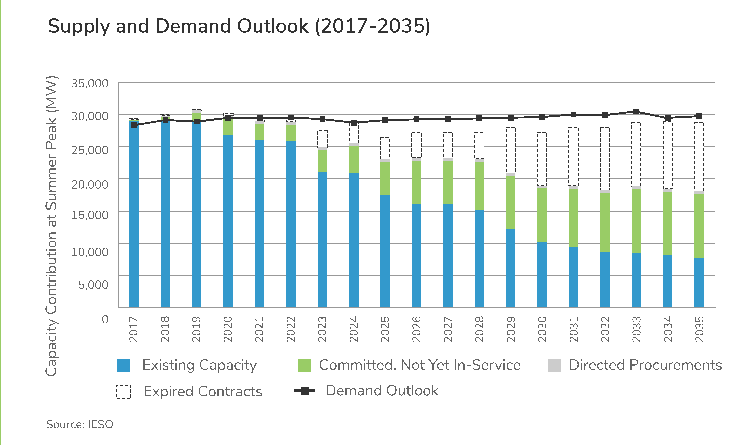A recent Globe and Mail article had the headline “Ontario faces electricity shortfall within five years”. This was based on the previous Liberal government’s 2017 Long-Term Energy Plan, which was released on October 26, 2017. You can download the report here (note the added notation at the top of the page, that this report is now considered out-dated), local copy here. As noted here, as much has changed in the past year, Ontario has begun a new process to forecast electrical demand and determine how to fulfill this.
The graph presenting this “electricity shortfall” is on page 37, and reproduced below (click on it for a larger view).
Note that the above graph is of the “Summer Peak” supply and demand, as Ontario’s power demand is always the highest in the summer (due to the use of air conditioning), and this drives planning, such as for; energy conservation programs, importing power, or planning new electricity generation capability.
The blue line in the graph above is of the flow (in cubic metres per second) down the Moon River, for the years 2006 to 2009. The red boxes highlight the summer flow (July and August) each year. Note the least flow is during the summer, exactly when Ontario has the peak annual electrical demand.
The other side of the problem is that the proposed Bala project would produce the most most power when it isn’t needed, such as in the spring when there is the least demand for electricity (because Ontario doesn’t need to heat or cool buildings at those times). But the proponent’s Feed-In Tariff contract would require the province to pay full rate for that power, which would need to be sold at a loss elsewhere. The article here (local copy here) shows this costs Ontario about $500 million dollars per year.
Therefore, the proposed hydro-electric generating station at the Bala falls would produce the:
- Least output during the times of Ontario’s peak electrical demand (such as summer), so it would not help solve any possible electricity shortfall in Ontario.
- Most output during the times of Ontario lowest electrical demand (such as spring), so it would contribute to Ontario wasting $500 million dollars per year selling expensive and unneeded electrical power at a loss.

